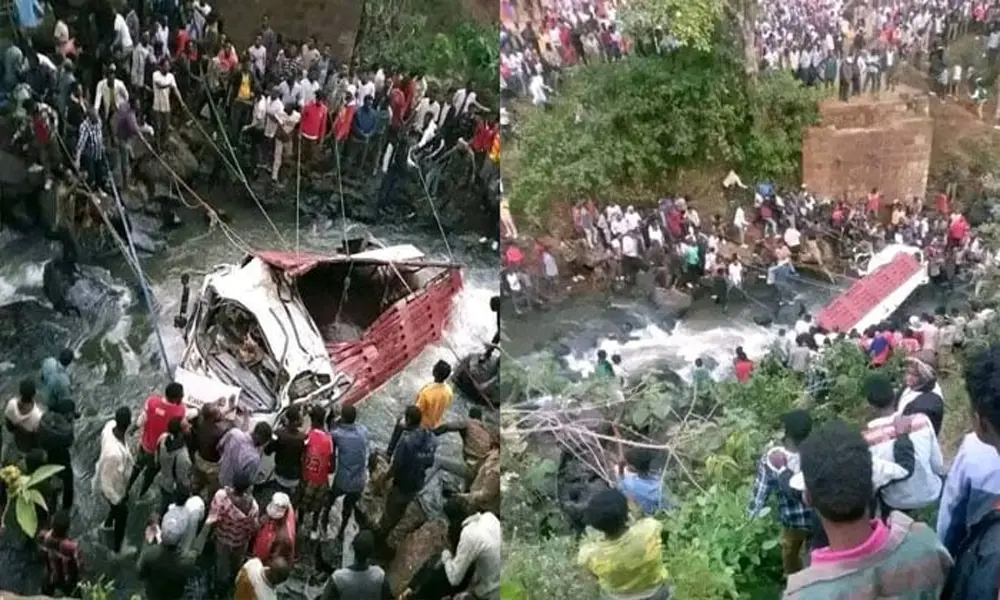Wedding Truck Plunges Into River in Ethiopia’s Sidama region claimed the lives of at least 66 people when an overcrowded truck fell into a river. The tragedy sheds light on infrastructure challenges, cultural practices, and transportation vulnerabilities in the country.
The Tragedy: Wedding Truck Plunges Into River
What began as a joyous wedding celebration ended in a heart-wrenching disaster on Sunday, as a truck carrying wedding guests plunged off the Gelan Bridge into a river in the southern Sidama region.
The truck, an older model, was overcrowded with passengers, a common practice in rural Ethiopia where trucks are often used to transport large groups due to affordability.
Witnesses described a festive atmosphere moments before the accident. Music blared from the truck, and passengers, dressed in formal attire, were dancing and waving as the vehicle made its way to the groom’s home. Tragically, this celebration turned into a scene of despair as the truck veered off the poorly constructed bridge and into the raging river below.
Read : Ethiopia: The Land of Ancient Civilizations and Rich Cultural Heritage
The immediate aftermath was chaotic. Villagers rushed to the site, attempting to rescue passengers with whatever tools they could find, including sticks.
Read : Why is Ethiopia Still Living in 2016: 8 Years Behind the Earth Time
However, the remote location of the village and delays in organized rescue efforts contributed to the high death toll. By the time help arrived, 64 people had died at the scene, and two more succumbed to their injuries at Bona General Hospital.
Underlying Causes: Infrastructure and Cultural Practices
The accident highlights multiple systemic issues that plague rural Ethiopia. Poorly maintained roads and infrastructure have long been a concern. The Gelan Bridge, in particular, has been described by locals as a hotspot for accidents, with no proper safety measures, warnings, or traffic bumps to slow down vehicles.
Resident Fasil Atara pointed out the lack of preventative measures on the bridge, which has seen numerous crashes in the past. In Ethiopia, such infrastructure inadequacies are not uncommon, especially in remote areas where resources are limited.

Another contributing factor is the reliance on trucks for mass transportation during social events like weddings. In many rural communities, trucks are a more affordable alternative to buses, allowing families to transport large groups of people. However, this practice often leads to overcrowding, which significantly increases the risk of accidents.
Cultural practices also play a role in these tragedies. In Ethiopian wedding traditions, male relatives and friends are customarily required to escort the bride from her home to the groom’s residence. This cultural expectation often results in large groups of men traveling together, as was the case in this accident.
A Pattern of Tragedies: Transportation Challenges in Ethiopia
The Sidama accident is not an isolated incident but part of a larger pattern of transportation-related tragedies in Ethiopia. Just a few months earlier, in August, a bus rolled over in the Amhara region, killing 38 people. Such accidents underscore the dire need for improved road safety measures and public transportation infrastructure in the country.
Ethiopia’s transportation challenges are multifaceted. The lack of accessible and reliable public transit options forces many rural communities to rely on unsafe alternatives like trucks and overcrowded buses. Additionally, poorly maintained roads, a lack of enforcement of traffic regulations, and inadequate emergency response systems exacerbate the risks.

The remote location of many villages further complicates rescue efforts. In the Sidama incident, villagers struggled to save passengers from the river without proper equipment, highlighting the need for better emergency preparedness and resource allocation in rural areas.
The tragic accident in Sidama serves as a stark reminder of the urgent need to address Ethiopia’s transportation and infrastructure challenges. Improved road safety measures, investment in public transportation, and the enforcement of traffic regulations could prevent such incidents in the future.
Additionally, cultural practices surrounding large gatherings and transportation must be reexamined to prioritize safety. Communities, local governments, and international organizations should collaborate to implement solutions that protect lives while respecting traditions.
As Ethiopia mourns the loss of 66 lives in this preventable tragedy, the incident should spark meaningful discussions and actions to ensure that such disasters are not repeated.
let’s enjoy few years on earth with peace and happiness….



